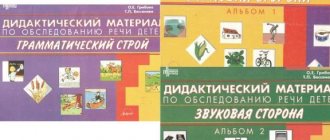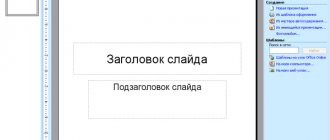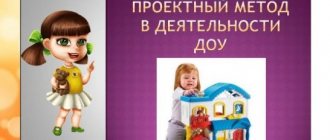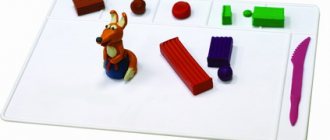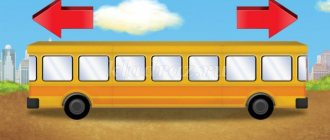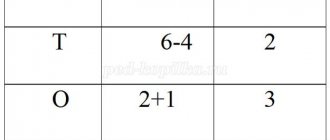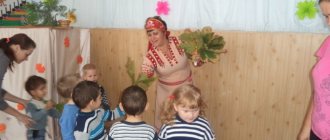Types of activities in accordance with Federal state requirements
There are generally accepted requirements that all preschool institutions in the country must adhere to. Thus, the main types of children's activities in accordance with FGT include the gaming component, communicative, labor, cognitive and research, musical and artistic, productive, as well as reading.
The general education program in kindergarten should be carried out not only through the interaction of an adult and a child. The child must solve many problems independently. Such activities allow you not only to acquire new skills, but also to consolidate existing ones.
Federal and state requirements are developed taking into account the regime of children in accordance with their age. Based on this, the main types of children's activities must be planned, taking into account periods of sleep and wakefulness.
Organization of the educational process in senior groups in preschool educational institutions in the context of the implementation of the Federal State Educational Standard
Bibliographic description:
Sayapina, L. I. Organization of the educational process in senior groups in preschool educational institutions in the context of the implementation of the Federal State Educational Standard / L. I. Sayapina, D. S. Chilikova. — Text: direct // Questions of preschool pedagogy. — 2022. — No. 5 (15). — P. 1-5. — URL: https://moluch.ru/th/1/archive/100/3507/ (access date: 01/03/2022).
In 2013, a new law “On Education” came into force, which states that kindergarten is the first compulsory stage of the educational process [4]. Preschool education should not only be accessible, but also of high quality. Therefore, from January 1, 2014, all preschool educational institutions switched to the Federal State Educational Standard for Preschool Education (FSES).
The standard pursues the following goals: “increasing the social status of preschool education; ensuring by the state equal opportunities for every child to receive quality preschool education; ensuring state guarantees of the level and quality of preschool education based on the unity of mandatory requirements for the conditions for the implementation of educational programs of preschool education, their structure and the results of their development; maintaining the unity of the educational space of the Russian Federation regarding the level of preschool education" [3].
What is changing in the educational process of preschool educational institutions in connection with the introduction of the Federal State Educational Standard for Preschool Education?
The text of the Federal State Educational Standard does not use the word “class” as a specially organized educational activity. But the learning process remains. The standard involves training in the senior group through the organization of various types of children's activities: play, communication, work, cognitive-research, productive, musical and artistic, reading. During the educational process, they alternate: children can study sitting on chairs, on a carpet, standing, in groups, in pairs, etc. [1].
The way children's activities are organized has also changed. If previously the teacher was in charge and the child was in control, now both the child and the adult are subjects of interaction, equal in importance.
At the present stage, we are seeing the inclusion of effective forms of working with children in the educational process: ICT, project activities, gaming, problem-based learning situations as part of the integration of educational areas.
High-quality preparation of visual materials is also very important. They should be modern and accessible to every preschooler. The illustrations and paintings used must be of high quality and large in size. Multimedia presentations are encouraged [2].
For example, to consolidate your knowledge of fairy tales and their names, you can use a presentation with riddles.
The Federal State Educational Standard for Educational Education sets requirements for the organization and updating of the subject-development environment. The subject-development environment in an institution implementing a preschool education program is one of the important criteria for assessing the quality of education.
Also, with the introduction of the Federal State Educational Standard, the structure of the school education for older preschoolers is changing:
- The introductory part involves creating a positive emotional mood for children’s activities. The child himself must become interested in the process, and for this motivation must be created. Motivation should unobtrusively, through play, encourage the child to take certain actions. Here everything depends on the literacy and competence of the teacher, because properly created motivation is the key to the success of the educational process.
Modern teachers have at their disposal a huge selection of ways to motivate students in the educational process, including theatrical activities with game characters, puppet performances and performances, multimedia equipment with which it is possible to create incredible stories and even reproduce direct interaction with children by recording voices and images.
Also important is the point of creating a problem situation (or a problem-search situation) for older preschoolers, the solution of which they will be engaged in throughout the entire educational activity. The problem should be understandable to preschoolers and not require unnecessary explanation. For example: Dunno came from Sunny City on an excursion to our city and got lost. Children help him get home, going through various obstacles and tasks. This technique develops mental activity in children, stimulates interest, and teaches interaction in a team or in pairs. Or: Children, I am Doctor Plyusheva. I invite you to a secret research laboratory, where you will get acquainted with the experiments carried out by scientists. But guess what you will explore.
- The main part of educational activity is a disguised game that will lead to a specific goal. In the main part of the OOD, the teacher is not limited in the ways of conveying information to students; the main thing is not to oversaturate the OOD with information. Various interaction methods can be used here: visual (demonstration of materials using multimedia equipment, watching films, audio and video instructions), practical (experimental activities, construction, didactic games and games with rules) and verbal (stories, reading, conversations).
Methods of organizing OOD such as online excursions and quest games are gaining great popularity.
An online tour (or virtual tour) is a spectacular and accessible way of visualization. The main advantage of such an excursion is the complete safety of children, and the fact that it saves time and money is also important. Organizing such excursions does not take much time; you can use ready-made excursions on various video hosting sites such as YouTube or organize excursions yourself using Google Maps or Yandex Maps. Virtual excursions allow you to make exciting journeys and create a complete illusion of presence in the viewer. Voskobovich’s unconventional games also provide additional motivation. The advantage of the game is the internal nature of motivation. Children play because they enjoy the gameplay itself. (see Appendix 1)
Quest game is a set of tasks (quests) united by something (plot, theme, characters, etc.). The most important elements are exploring the world (plot) and solving problems. OD organized in the form of a quest game not only effectively solves the problem of motivation, but also helps with maintaining interest during the activity process, since activities in a quest game change quickly enough, and the child does not have time to get tired.
Analysis is an essential part of any activity. The teacher notes the positive aspects of each child’s work as a basis; the negative aspects are not clearly mentioned, but so that the child would pay attention to this and be able to improve his results in the future. It is also important to maintain the predominance of positive emotions and a friendly atmosphere in the children's team during analysis. The analysis is carried out in several ways:
- Analysis on behalf of the teacher.
- Analysis from the perspective of a game character participating in the OOD plot.
- Self-analysis of children (with the help of a teacher).
A distinctive feature of educational activities according to the Federal State Educational Standard for Preschool Education is the speech activity of preschool children. Communication between teacher and student should be based on the principle that the child is the doer, and the teacher is the assistant. Most of the speech activity should fall on children; the teacher’s questions should encourage active speech activity, be of a problem-searching nature, and develop logical thinking. The teacher needs to structure his speech in such a way that all speech activity is transferred to the child, and he gives complete and detailed answers to questions.
For example:
1) Children and foxes were walking and got lost. They really want to go home. How can I help them? (The child will independently offer options for help.)
2) I can’t see something well. Who can describe this picture to me? What's written on it? (The child will strive to describe the picture as accurately as possible using more words and more complex speech structures)
3) Who can name the most objects similar to a square? (Activation of the competitive effect. Thought and speech processes are activated in more productive activities. The child uses more words)
It is not unimportant for the teacher to formulate his phrases in such a way as to avoid imposing a plot or actions (“I want to invite...”). It would be more correct to say to the children this way: “Let's go on a trip...”
3. Final part. Part of the OOD, where students achieve their goals and find solutions to all problem and search situations. In this part of the educational activities, it is necessary to pay attention to the outcome of all actions taken and consolidate the acquired knowledge in the course of educational activities. Consolidation of knowledge can occur both in the format of a conversation and in the format of practical activities (draw a picture, make an application, etc.). The conclusion of the OOD is a general analysis of the activities carried out at the end of the educational process (3 methods). We cannot cancel such an important fact as incentives based on the results of the OOD; such incentives can be stickers with emoticons (laughter, smile, etc.), stars (3 - excellent, 2 - good, 1 - try) and much more that will motivate children to perform effectively or maintain their high level of activity in the future.
Thus, we can conclude that currently the requirements for conducting educational activities have changed, since there are pedagogical technologies (problem-based learning, research activities, project activities, health-saving technologies, etc.) that must be used in the implementation of the Federal State Educational Standard for Education.
Annex 1
Theatrical activities
"Miracle Tree"
Voskobovich games
Literature:
- Denisova N. I. Practical advice for conducting classes on the Federal State Educational Standard of a Preschool Educational Institution [Electronic resource]. — Access mode: https://wwwukdou15.caduk.ru/DswMedia/praktsovetyipoprovedeniyuzanyatiypofgos.pdf.
- Mayer A. A. Practical materials on mastering the content of the Federal State Educational Standard in a preschool educational organization [Text]: educational and practical guide / A. A. Mayer. — Moscow: Ped. island of Russia, 2014. - 93 p.
- Federal State educational standard for preschool education [Text]: approved by order of the Ministry of Education and Science of the Russian Federation dated October 17, 2013, No. 1155 / Ministry of Education and Science of the Russian Federation. — Moscow: 2013
- Federal Law on Education in the Russian Federation: adopted by the State Duma on December 12, 2012 // ConsultantPlus [Electronic resource]. –
Key terms
(automatically generated)
: preschool education, child, educational process, educational activity, teacher, multimedia equipment, main part, project activity, speech activity, Federal State Educational Standard.
Play activities in kindergarten
The game can rightfully be called the main activity in a preschool institution. Role-playing games help the development of personality, active ones contribute to the rapid physical development of the child. Any training is much more productive if it is interesting to the child. It is no coincidence that many educational programs are built in the form of a game.
The entire preschool age of a child can be divided into two groups. In early preschool age, games largely acquire an objective character. Children explore the world around them visually. They try to distinguish one object from another and taste it. In older preschool age, children already begin to interact with each other. Role-playing games are becoming popular. And if the teacher organizes the educational process correctly, it will be possible to teach children writing and reading in the form of a game. All types of children's activities in kindergarten should be related to it to one degree or another.
Types of children's activities and ways to support them
Svetlana Maltseva
Types of children's activities and ways to support them
1. The pedagogical dictionary notes that the concept of “initiative”
can be defined as an initiative,
“the first step”
towards the beginning of some action.
2. In the Constitution of the Russian Federation, in the “Concept for the modernization of Russian education”
, the Law of the Russian Federation
“On Education in the Russian Federation”
and other regulatory documents of the Russian Federation formulate the state’s social order for the education system: education of an initiative, responsible person, ready to make independent decisions in a situation of choice.
3. The Federal State Educational Standard states that one of the main principles of preschool education is to support children in various types of activities . Support for the initiative is also a condition necessary for creating a social situation for the development of children. At the stage of completion of preschool education, the targets defined by the Federal State Educational Standard include the following: • show initiative and independence in various types of activities ; • choose your occupation, participants in joint activities ; • demonstrate the ability to exercise volition ; • independently come up with explanations for natural phenomena and people’s actions; • demonstrate the ability to make your own decisions.
4. The development of children's initiative and independence is carried out:
IN DIFFERENT TYPES OF EDUCATIONAL ACTIVITIES . 1. gaming; communicative, cognitive-research, perception of fiction and folklore, productive, musical, motor, elementary labor; directly organized; in regime moments in independent; activities ; 5. Without independence, we will not get initiative. For a long time there was an opinion that a child is not yet a person. A small child is an inferior being who cannot think, act independently, or have desires that do not coincide with the desires of adults. The child must fulfill the requirements dictated by the adult without showing his own initiative and independence. “said and done” principle
.
And only recently have we adopted “positive”
approach to the development of a child: he has been recognized as having the right to be an individual. And independence is a faithful companion to personal development.
6.Development of independence:
The first stage is when the child acts in his usual conditions, in which basic habits were developed, without reminders and help from adults (we wash our hands before and after eating; we say “hello”
,
“goodbye”
,
“thank you”
,
“please”
; put toys back in place; clean up the room, etc.).
The second stage - the child independently uses familiar methods of action in new , unusual, but close and homogeneous situations (clean up order in the group; sweep the floor at grandma’s, etc.)
.
Third stage – long-distance transfer is possible. The rules have been mastered and the child uses them in any situation.
7.Characteristic features of developed independence:
a) the ability to perform work on one’s own initiative, to notice the need for certain actions (water flowers if the ground is dry; when you see a mess, eliminate it)
;
b) the ability to perform work without outside help, without the constant supervision of an adult;
c) consciousness of actions, the presence of basic planning (the ability to understand the purpose of the work, foresee its result)
;
d) the ability to give a fairly adequate assessment of one’s work and exercise basic self-control;
e) the ability to transfer known methods of action to new conditions.
8 The lag in the development of independence and initiative in preschool children is largely a consequence of improper organization of children’s activities and upbringing errors:
a) excessive regulation of activities ,
b) constant control and guardianship,
c) the predominance of direct methods of directing children’s actions,
d) teaching actions by directly imitating an adult’s display, etc.
9. Stages of development of a child’s independence of plans.
2-3 years - testing yourself in the external field (who I am)
;
3-5 years - the emergence of a conscious and verbally formulated plan and testing of my ideas in different areas (what I can do)
;
5-7 years - subordination of actions to a conscious sustainable plan, a clear subjective division of the spheres of initiative (where I can)
10 Initiative and independence in preschool children are formed gradually, one after another.
11 Ways and directions of supporting children's initiatives.
1. Joint activity between an adult and children , based on the search for solutions to a problem situation proposed by the child himself.
2. Project activities .
3. Joint cognitive and research activities of adults and children - experiments and experimentation
4. Observation and basic household work in the experimentation center.
5. Joint activity of adults and children to transform objects of the man-made world and living nature.
6. Creating conditions for independent activity of children in development centers
12. Children's initiative is manifested in the free activity of children according to their choice and interests. The opportunity to play, draw, design, compose, etc., in accordance with one’s own interests, is the most important source of a child’s emotional well-being in kindergarten . In the form of independent initiative activities in kindergarten, types of activities of the child can be carried out , since each activity has a unique impact on the development of different components of independence
13. Conditions necessary for the development of children's initiative.
1. Developmental subject-spatial environment.
2. The content of the developmental environment should take into account the individual characteristics and interests of children of a particular group.
3. The democratic style of communication between teachers and children should prevail in the group. 4. Educators and parents must develop children’s skills to choose activities and relationships in accordance with their interests.
5. Parents should be aware of everything that is happening in the child’s life: what he is doing, what new things he has learned, what he needs help with in his search.
14. Types and directions of children's initiative :
1. creative initiative - involves the child’s involvement in a story-based game as the main creative activity , where imagination and imaginative thinking develop;
2. initiative of productive activity - drawing , modeling, constructive modeling, where voluntariness and the planning function of speech develop;
3. communicative initiative - involves the child’s involvement in interaction with peers, where empathy and the communicative function of speech develop;
4. cognitive initiative - presupposes curiosity, involvement in experimentation, simple cognitive and research activities , where the ability to establish spatio-temporal, cause-and-effect and generic relationships develops.
15. Manifestations of children's initiative at different ages.
2-3 years
The priority area for the manifestation of children's initiative at this age is research activity with objects , materials, substances; enriching your own sensory experience of perceiving the world around you.
3-4 years
The priority area for the manifestation of children's initiative is play and productive activities .
4-5 years
The priority area for the manifestation of children's initiative at this age is cognitive activity , expanding their information horizons, and playing activities with peers .
5-6 years
The priority area for the manifestation of children's initiative in older preschool age is non-situational - personal communication with adults and peers, as well as information and cognitive initiative.
16. “Balance of adult and child initiative :
This is achieved not through a rigid separation of the spheres of domination of an adult and the freedom of a child, but through the flexible design of partnership activities , where both parties act as central figures in the educational process and where pedagogical interests and the interests of a specific group of preschoolers meet, and are not opposed.”
Recommendations for teachers to stimulate the initiative of children's creative activity.
1. Providing a favorable atmosphere. The goodwill on the part of the teacher, his refusal to express assessments and criticism of the child contribute to the free manifestation of divergent thinking (it is characterized by speed, flexibility, originality, accuracy)
.
2. Enriching the child’s environment with a wide variety of objects and stimuli that are new to him in order to develop his curiosity.
3. Encouraging the expression of original ideas.
4. Using a personal example of a creative approach to problem solving.
5. Provide opportunities for exercise and practice. Widespread use of divergent questions across a wide variety of areas.
6. Giving children the opportunity to actively ask questions.
7. Systematically enriching the life experience of children.
8. Collaborative (educational)
games between a teacher and children aimed at imparting gaming experience to them.
9. Timely changes in the subject-play environment, taking into account the enriching life and play experience of children.
10. Activating communication between an adult and children, aimed at encouraging them to independently apply new knowledge in the game, ways to solve game problems, facilitating children’s interaction with each other.
Cognitive and research activities
An equally important activity can be considered cognitive and research. This species is quite closely related to the game. After all, it is thanks to the latter that the child gets acquainted with the world around him. Cognitive activity is of great importance at any childhood age. Depending on the goals that the teacher sets for the children, this type of activity may include experimentation, observation, and excursions.
Special attention should be paid to targeted walks. In the warm season, thanks to trips to the park or out of town, the teacher helps children solve several problems at once. Active recreation can be combined with getting to know nature and animals of your native land. In addition, fresh air helps improve children's appetite and sleep. An obstacle to daily walks may be too low an air temperature or precipitation. In the summer, teachers should ensure that children spend less time in the open sun and wear hats. Almost all types of children's activities in kindergarten in summer can be carried out in the fresh air.
Communication type of activity
The main task of a preschool institution is to prepare the child for future adult life. A little person must acquire many skills before he enters society. This is not only the ability to speak or use household objects for their intended purpose, but also proper communication with others.
Most children easily find a common language with both peers and adults. But in every preschool institution there is always a group of withdrawn children who find it difficult to socialize. This behavior may be due to personality traits or parental upbringing. Often, troubles in the family lead to the child withdrawing into himself and not wanting to communicate with his friends. The main types of children's activities are aimed at helping such a child. In a playful way, the teacher helps him open up and establish contact with peers.
Properly organized communicative activities in kindergarten also contribute to the development of the children’s speech apparatus. Activities may include communication with children on certain topics, situational tasks, conversation, and solving riddles. Story-based games are extremely popular among children. In the role of their favorite fairy-tale characters, children become more self-confident and reveal their creative potential.
Specific children's activities, taking into account the age characteristics of children in the context of the Federal State Educational Standard for Education.
Olga Sergeevna Nazmutdinova, methodologist, Rybno-Slobodsky kindergarten “Mishutka”, Rybno-Slobodsky municipal district of the Republic of Tatarstan
Specific children's activities, taking into account the age characteristics of children in the context of the Federal State Educational Standard for Education.
Clause 2.7 of the Federal State Educational Standard for Preschool Education states that the content of preschool education is determined by the goals and objectives of the Program and can be implemented in various types of activities (communication, play, cognitive and research activities - as end-to-end mechanisms of child development).
One of the main tasks of the Federal State Educational Standard is to support children's initiative and independence in various types of children's activities: gaming, communicative, creative, constructive, labor, cognitive, research, project.
The development of cognitive and research activity largely depends on the child’s living conditions. The more complete and varied the material provided to him for research activities, the more likely it will be to timely pass through the stages of development of perception, thinking, and speech. Below is a table of specifically children's activities, taking into account the age characteristics of children.
| Infancy (2 months - 1 year) | Early age (1-3 years) | Preschool age (3-7 years) |
| Direct emotional communication with adults (situation of inextricable unity of child and adult) | Object activities and games with composite and dynamic toys | Game activities (role-playing games, games with rules) |
| Manipulating objects | Experimenting with materials and substances (sand, water, dough, etc.) | Communication activities (communication and interaction with adults and peers) |
| Cognitive and research activities | Communication with an adult and joint games with peers under the guidance of an adult | Cognitive and research activities (studying objects of the surrounding world and experimenting with them) |
| Perception of music, children's songs and poems | Self-care (washing, brushing teeth, combing your hair, undressing and dressing with partial assistance from an adult), and actions with household tools (spoon, scoop, spatula) | Perception of fiction and folklore (formation of a holistic picture of the world, including primary value ideas; development of literary speech) |
| Physical activity | Perceiving the meaning of music, fairy tales, poems, looking at pictures | Self-care (washing, brushing teeth, combing your hair, dressing and putting clothes away, tying shoelaces) and basic household work indoors and outdoors (hanging clothes in the closet, watering indoor plants, picking herbs in the garden, raking leaves) |
Labor activity in a preschool institution
In order to exist in a full-fledged society, a child needs not only to learn how to communicate correctly, but also to serve himself. All types of children's activities in kindergarten help children learn independence. They must be able to dress properly and hold kitchen utensils without adult assistance.
Household work is also not in last place. The child must be familiar with the activities of adults. This is especially true for household tasks. Not only the teacher teaches children the culture of life, but also the parents at home. Even in preschool age, parents together with educators must teach the child to be neat. All children must clean up toys and kitchen utensils after themselves. A preschooler must know that all things have their places.
Joint activity between an adult and a child also contributes to social development. The baby quickly learns to solve certain everyday problems and begins to understand the degree of his importance in society.
Productive activity
It is impossible to imagine classes in kindergarten without drawing, modeling and applications. These are all productive activities that promote mental development. In classes, kids learn to express their thoughts and show imagination. It is in kindergarten that a love for art can begin, and parents usually identify one or another talent in the child at this time.
Praise is a very important aspect of productivity. Under no circumstances should you point out mistakes to a preschool child. The teacher can only guide the child, suggest how it would be optimal to solve a specific problem. It is no coincidence that there is no assessment system in preschool institutions. The child should not know that he is drawing or making appliqué worse than others.
Productive activities in kindergarten help introduce the child to the surrounding nature, basic colors and shapes. In addition, drawing and modeling contribute to the development of motor coordination.
Characteristics of the main types of activities of children and features of their organization in preschool educational institutions
Definition 1
Activity is a process (processes) of active interaction between a subject and an object, during which the subject satisfies any of its needs and achieves a goal.
The leading activity of a preschool child is play. It is in play that a child has the opportunity to “try on” various social roles; in the process of play, children develop speech, thinking, imagination, cognitive processes and form the necessary practical skills.
There are the following forms of organizing the game:
- A role-playing game is a game that involves a certain plot and the distribution of roles between participants.
- Theatrical games are a variety of role-playing dialogues, dramatizations, imitation games, improvisation games and dramatizations.
- Director's games are games that use character toys or substitute objects.
- Fantasy games are games that are mainly represented by TRIZ technologies.
- Games using building materials (cubes, building sets, natural materials, etc.).
- Experimentation games – games using a variety of materials (water, ice, light, paper, magnets, etc.)
- Didactic games - represented by board-printed, word games and games with objects.
- Intellectual development games are games that use puzzles, mazes, etc.
- Outdoor games - represented by plot, plotless, folk, sports, etc. games.
Are you an expert in this subject area? We invite you to become the author of the Directory Working Conditions
Regardless of the type and form of organization, all games are aimed at the personal development of the child and meeting his age-related needs.
Definition 2
Educational activity is a specially organized or independent process, during which a child acquires certain knowledge and skills, expands his own horizons and acquires practical skills.
There are the following types of organization of educational activities:
- Organized partnership (joint) activity between the teacher and children implies the inclusion of the teacher in organized activities on an equal basis with the children. The inclusion of children in joint activities is based on the voluntary desire of the children; any coercion to participate is not allowed.
- Organization of educational activities at different scheduled moments is an educational activity that the teacher organizes and conducts during a walk, in the morning and evening hours and at other scheduled moments during the day. This type of activity can be organized in the form of outdoor games with rules, conversations, hardening, analysis of various problem situations, etc.
- Organized educational activity that involves direct interaction between the teacher and one child, with a subgroup of children or with the entire group. The choice of a pupil or pupils depends on their age, individual characteristics and the type of activity being organized.
- Independent activity of children is carried out at regular moments of the day, lasting at least 3-4 hours a day. Independent activity does not mean that children are left to their own devices. The teacher’s task is to create the necessary conditions for them and organize a subject-spatial environment for productive and interesting independent activity.
Finished works on a similar topic
Course work Organization of various types of activities and communication of children 460 ₽ Abstract Organization of various types of activities and communication of children 270 ₽ Examination Organization of various types of activities and communication of children 190 ₽
Receive completed work or specialist advice on your educational project Find out the cost
Definition 3
Labor activity is a purposeful activity, the main task of which is to develop in children a respectful attitude towards work, as well as the development of the necessary labor skills.
The labor activity of children can be organized in the form of:
- Self-care is an activity aimed at the child serving himself during hygiene procedures, eating, dressing and undressing, etc.
- Duty - organized in the dining room, in a corner of nature and joint educational activities, when 2-3 children assist the junior teacher or teacher.
- Household work - represented by organized cleaning of the group room, toys, repair of books, clothes, toys, etc., under the guidance of a teacher.
- Work in nature - organized cleaning of the site, procurement of natural materials, snow removal, making bird feeders, work in the summer area (watering flower beds, weeding, etc.).
- Manual labor is the organized activity of making crafts from waste and natural materials, making various attributes for games, etc.
Musical and artistic activities
Musical activities for children in kindergarten include singing, humming along, playing instruments, as well as outdoor games with musical accompaniment. In such classes, children develop their creative abilities. Many children enjoy classes with vocal improvisation. It is musical and artistic activities that were created to prepare children for performances. Children learn to feel great in front of a large audience.
Reading in kindergarten
Despite the fact that children begin to read only at school age, educators should teach this skill long before that. The child must first learn to listen and understand the work. A very important skill is the ability to handle a book. The child should know not to tear the pages while looking at the illustrations.
In the middle group, the teacher begins to introduce children to letters. First of all, children learn easy to pronounce letters. These are simple vowels and consonants. Next, kids learn to put letters into syllables, and them into words.
A child’s activities in kindergarten must necessarily involve learning short poems. Activities of this kind promote mental development and train the child’s memory. Parents can also learn short stories and jokes with their children at home.
Proper organization of leisure time is also important
Teaching a child's basic skills in a preschool comes first. But properly organized cultural and leisure activities in kindergarten are also important. In order for children to be able to usefully spend their free time in a group, the space must be properly organized. Adults should pay special attention to toys. Appropriate areas in the form of a living corner, kitchen or pharmacy are of great benefit. Special toys make children's role-playing games more intense.
The conditions for the implementation of children's activities in kindergarten also include theatrical events. Performances and fairy tales help children better consolidate the material they have covered. In addition, favorable conditions are created for the comprehensive development of the child within the preschool walls.
Nanny or kindergarten?
Today, more and more parents prefer raising children at home. Meanwhile, it is in a preschool institution that a child can acquire skills in social-role behavior. Children experience communication in a wide variety of forms. Even a negative experience that cannot be gained within the walls of one’s own home will benefit the child. And play, as the leading type of children’s activity, will contribute to the comprehensive development of the child in a team.
At the same time, raising a child at home also has advantages. A nanny with a pedagogical education will make every effort to raise a particular child, taking into account the characteristics of his character. This will provide an opportunity to cultivate the best qualities in him.
Development of a child’s speech through different types of children’s activities
Development of a child’s speech through different types of children’s activities
One of the leading tasks that preschool educational institutions solve, in the context of educational areas, is the development of children’s speech
.
Speech as the leading means of communication accompanies all types of child activity.
.
his authority and status position
on the quality of speech
, the ability to use it in play, during joint
activities between the teacher and the child
, when planning and discussing a drawing, while observing a walk, when discussing a performance, etc. in the children's community
.
Formation of correct speech
is one of the main tasks of preschool education. However, a dynamic analysis of the practical situation over the past few years indicates an annual increase in the number of preschool children with speech disorders.
Today – figurative
Speech rich in synonyms, additions and descriptions in preschool children is a very rare phenomenon.
Therefore, it is necessary to take care of the timely formation of children’s speech
, its purity and correctness, preventing and correcting various violations, which are considered to be any deviations from the generally accepted forms of the Russian language.
Based on the above, the team identified the following tasks for speech development
.
1. Enrich the cognitive-speech sphere of children with information through classes
, observations, experimental
activities
, speech.
2. Enrich emotional and sensory experience in the process of direct communication with objects, phenomena, and people.
3. Create conditions that facilitate the identification and maintenance of interests, the manifestation of independence in cognitive and speech activity
.
4. Maintain conditions for development
cognitive and speech processes of preschool children in all types
of activities
.
In the work practice of teachers, the following forms of work are used by type of educational activity
.
— regime moments
- joint activities of the teacher and children
- independent activities of children
- joint activities with family
.
Practical implementation of the specified system of work on speech development
contributes to the development of speech activity, the foundations of
the child’s
.
Features of integration of educational areas in the speech development of preschool children
.
Speech communication in preschool age is carried out in different types of activities
: in play, work, household, educational
activities
and acts as one of the sides of each type.
Therefore, it is very important to be able to use any activity to develop speech
.
First of all, speech development
occurs in the context of leading
activity
.
In relation to young children, the leading activity is object-based activity
; for preschool children, play
activity
.
